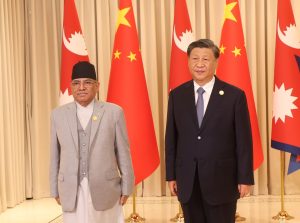On September 30, Prime Minister of Nepal Pushpa Kamal Dahal, also called “Prachanda,” flew back to Kathmandu after concluding an eight-day visit to China. At the Tribhuvan International Airport, Dahal answered questions about his visit, and Nepali officials released a 40-point press note. Conspicuously missing from both was any mention of China’s ambitious Belt and Road Initiative (BRI). Furthermore, out of the 12 MoUs that Dahal returned with, none were signed under the framework of the BRI.
Nepal signed on to China’s ambitious infrastructure project in 2017. Six years later, the two countries have almost nothing to show for it. This much was made embarrassingly clear by Nepali Foreign Minister N.P. Saud in June, after China unilaterally and falsely claimed Pokhara International Airport as the BRI’s flagship project in Nepal, a day before its inauguration. Saud was forced to clarify that “not a single project in Nepal under the BRI has been executed.”
A major reason for the BRI’s failure to take off in Nepal, is that the 2017 MoU has no provision for funding modality. The BRI Implementation Plan is supposed to shed light on this, and other important pending concerns. It has been widely reported that Nepali leaders want grants for projects, instead of soft loans proposed by China. In 2021, then-Prime Minister Sher Bahadur Deuba (now a coalition partner of Dahal) clarified the same to his Chinese counterparts. That it took four years for Nepal to articulate such a fundamental position in itself is quite telling of problems with the BRI.
Ahead of Dahal’s visit, the BRI Implementation Plan was touted as a big ticket item on the agenda, and some even hoped that Beijing and Kathmandu would be able to iron out differences over the document, which has already gone through several revisions. Officials from the National Planning Commission, the Prime Minister’s Office, Foreign Ministry, and others scrambled to get Cabinet approval. However, no consensus could be reached in time.
A decision was made that Dahal would discuss the plan nonetheless. Yet, the joint statement issued by the Nepali Ministry of Foreign Affairs mentioned the BRI Implementation Plan just once, and expressed the commitment of both sides “to accelerate the consultations to finalize the text on the BRI Implementation Plan at an early date.” In diplomatic speak, this can be read as a standard non-committal commitment.
The larger picture here includes legitimate Nepali concerns over the state of their economy. Nepal’s deficits are burgeoning, and Nepal’s high trade deficit with China ($1.84 billion in imports vs $5.39 million in exports in 2022) does not help. Furthermore, increasing reports of Nepal’s South Asian neighbors (and others elsewhere) falling into debt traps under the BRI have not gone unnoticed.
It was also in this context that Kathmandu finally ratified the U.S.-funded Millennium Challenge Corporation last year, which came in the form of a $500 million grant. At the time, Kathmandu received significant backlash from Beijing, and bilateral relations reached its lowest point.
It seems that the Chinese are yet to completely forgive Nepal. For instance, during the visit, Dahal was expected to request that Beijing waive off loans for the aforementioned Pokhara International Airport. Furthermore, he was also going to seek an agreement on cross-border energy trade (to diversify from Indian markets), and a grant for a mega BRI project. On all counts, Beijing made no concessions.
Chinese reticence would perhaps be easier to swallow for Nepal if Beijing was more considerate of Nepali interests or genuine concerns. For starters, China’s new “standard map” effectively dismissed Nepal’s new political map released in 2020, which came as a rude shock to Nepali politicians. Perhaps an even more telling example is the case of the proposed China-Nepal free trade agreement (FTA) under the framework of BRI. It came to the attention of Kathmandu’s strategic community last year, when the full text of the MoU signed in 2017 was finally leaked. The Chinese economic analysis had apparently concluded that Nepal would benefit from an FTA. However, the Nepali Ministry of Industry, Commerce and Supplies came to the opposite conclusion and recommended that Nepal not move forward with the deal, as it would only increase the trade deficit.
To come back to the Pokhara International Airport once again, a recent New York Times investigative report flagged multiple malpractices by a Chinese firm (the principal contractor) during the construction of the airport. In addition, it revealed a disregard for construction quality, safety, and of course, Nepali taxpayers. To make matters worse, contrary to Chinese assurances, the airport has thus far failed to attract any international business whatsoever.
Such examples have increased Nepali leadership’s skepticism of Beijing, even if public rhetoric may indicate otherwise. Therefore, it was no surprise to close observers when two out of the nine projects proposed under the BRI framework, were awarded to Indian companies instead – namely the Tamor Hydroelectricity Project and the Phukot Karnali Hydroelectric Project – during Dahal’s visit to India in June this year.
Yet, instead of addressing long-standing Nepali concerns during Dahal’s visit, Beijing tried hard to press its new initiatives onto Nepal, such as the Global Development Initiative (GDI), Global Civilization Initiative (GSI), and Global Security Initiative (GSI). Dahal did manage to keep out of the GCI and GSI, citing Nepal’s policy of non-alignment on the latter. Kathmandu decided to support the GDI, arguably because it can ill-afford to further attract the full ire of Beijing. But if the BRI’s failure in Nepal is anything to go by, new initiatives will similarly amount to nothing, unless Beijing decides to meaningfully engage with Kathmandu.
China surely knows this by now. Whether it cares is an open question.

































